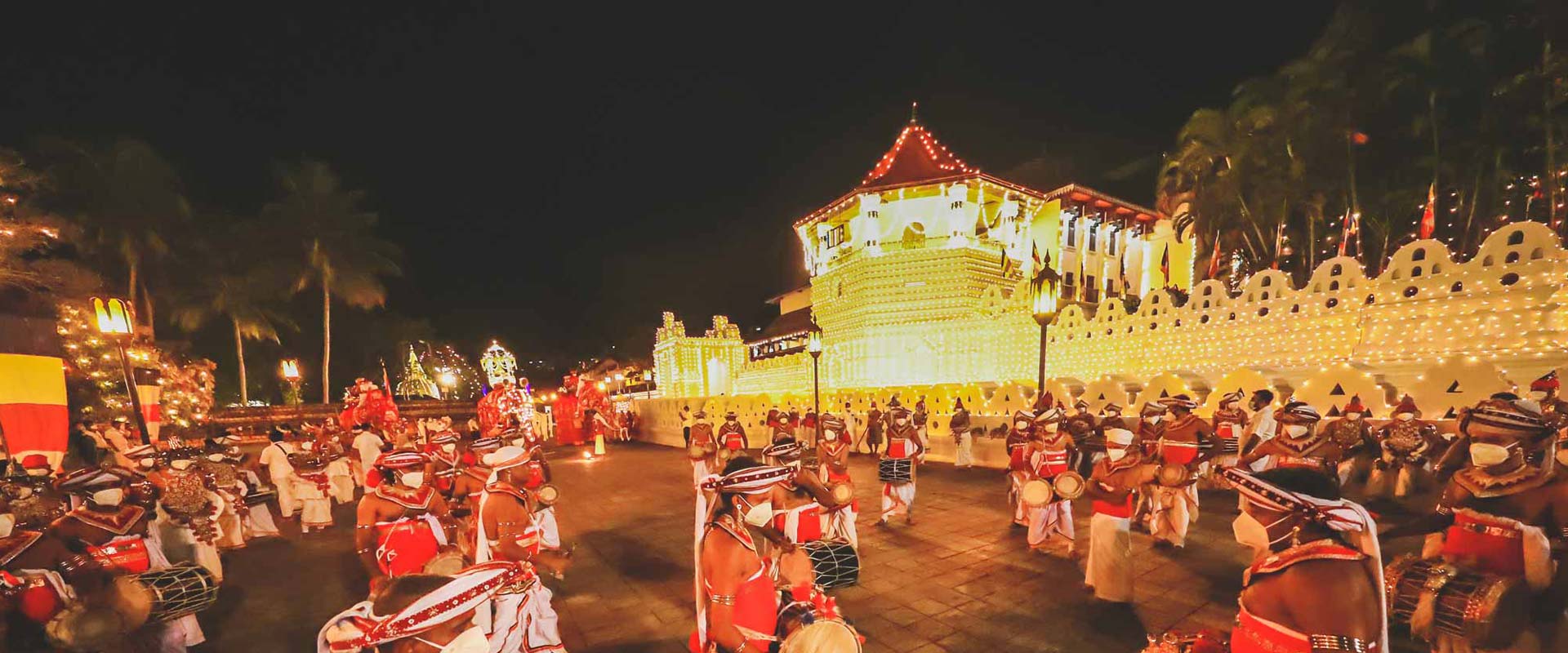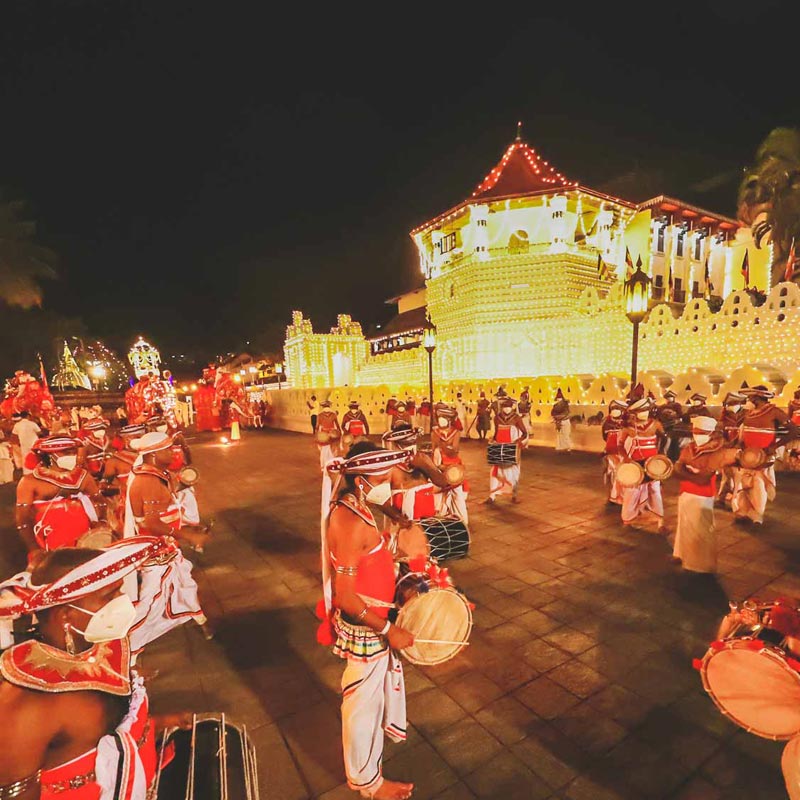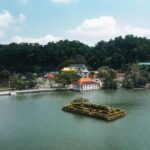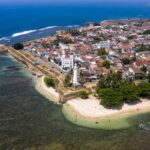Explore Kandy, The Hill Capital of Sri Lanka
Situated on a plateau and surrounded by mountains, Kandy is the largest city in the in Central region and is known as the Hill Capital of Sri Lanka. Kandy is home to tea plantations and a bio diverse rainforest right within the city.
Kandy is known best for the sacred Buddhist sites including the Temple of the Tooth relic (Sri Dalada Maligawa) shrine which is celebrated with an annual procession best known as the grand Esala Perahera. The heart of the city, the Kandy Lake (that was also known as the Bogambara lake), is very popular for a relaxing stroll during your stay in the city.
Kandy is the ideal city to go on technical tours related to arts such as gem crafting, woodcarving and batiks and watch the Kandyan Cultural Show with its colorful traditional dances and delightful music.
Kandy Cultural Show
The Kandy Cultural Show gives an opportunity to experience some of the most revered traditions of Sri Lanka. Some of the most popular art forms of the island take to the stage in this hour-long extravaganza as. Fire dancers and sword dancers will wow you as the colorful Kandyan dancers take to the air to the thrumming primal beat of the drums.
The Kandyan Dance was adapted for the stage by Chitrasena Dias in the 1970s. His popularity helped reduce the caste barriers surrounding the dance and made it more palatable to an urban, contemporary audience. Traditional and ritual Kandyan dance is still taught in some village dance schools.
Temple of the Tooth Relic (Sri Daladà Màligàwa)
The Temple of the Sacred Tooth Relic is a world-renowned place of worship, where the left Canine tooth of Gautama Buddha is enshrined. The Sacred Tooth Relic was brought to Kandy from the Kingdom of Kalinga, India, in 371 A. D. by Prince Danta and Princess Hemamala during the reign of king Kithsiri Meghavanna. The temple which is venerated daily by thousands of local & foreign devotees and tourists was named as a world heritage by UNESCO in 1988.
The temple carries a lot of value to Buddhists all over the world and also has immense cultural value. The architecture is uniquely Kandyan, with a combination of the unique style used to build “Dalada Mandira” the shrines which housed the Sacred Tooth Relic previously in other kingdoms.
The temple of the Sacred Tooth Relic is built in the city of Kandy near the ancient Royal Palace which is situated to the North of the temple and the forest reserve called “Udawaththa Kelaya” to the East. The famous Kandy Lake also known as “Kiri Muhuda” to the South and “Natha & Paththini Devala” on the West. The temple is adorned with intricate carvings using gold, silver, bronze, and ivory.
Originally built by the Kandyan Kings in 1595, the Temple is considered to be one of Sri Lanka’s most holy shrines and attracts crowds of white-clad pilgrims bearing lotus flowers for means of worship.
Although you may not view the actual tooth itself, the casket within which it is said to be is displayed twice a day. The best time to view this ornate casket is around 6.30pm.
The Temple of the Tooth is an art and history lovers’ paradise. From the large carved entrance arch with its elephants on either side to the carved ‘welcome mat’ on the ground, also known as the ‘moon stone’ beautifully detailed and elaborate paintings covering the insiders of the shrine.
The shrine’s low curved ceilings of corridors and paved floors with their stones polished by a million feet transports its visitors to a different age when kinds walked the soil of Sri Lanka.
In addition to the main shrine, the attractions at the Maligawa includes the Royal palace (which is now an archeological museum) and the Audience chamber (now a chamber for ceremonies) and various other associated structures.
The temple is open from dawn to dusk and involves the purchase of a ticket to enter. It is important to be dressed very conservatively when visiting the temple by making sure to cover up below the knees and shoulders. As a mark of respect, all headwear as well as footwear is removed prior to entering the Temple and everyone walks in barefoot. The Pooja (a small ceremony of reverence involving drummers and dancers) times of this historic temple are 6:30am, 9:30am and 6:30pm
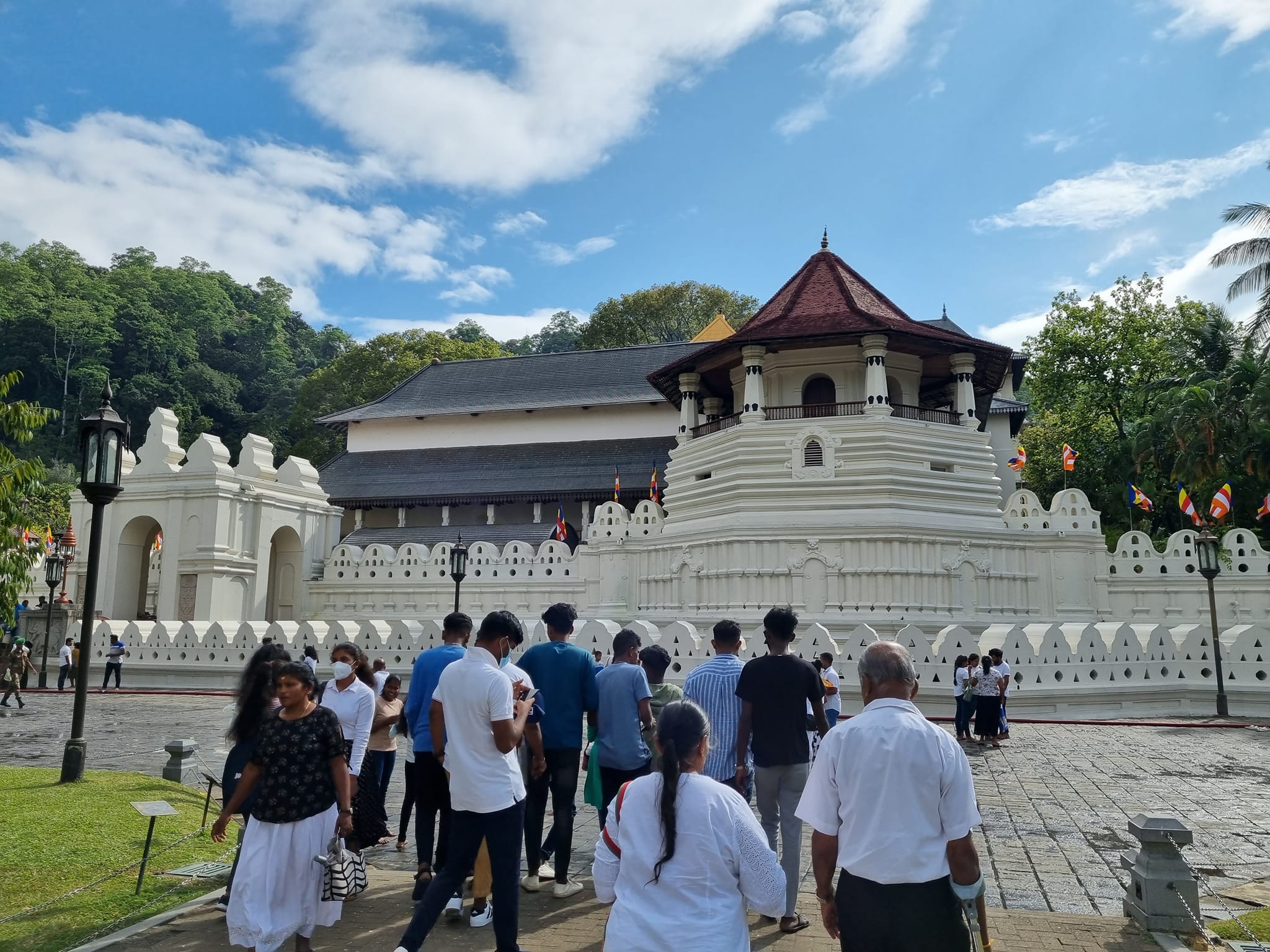
Udawattakele Forest Reserve
Udawatta Kele is a historic forest reserve that can be found on a hill-ridge in the city of Kandy. During the days of the Kandyan kingdom, Udawattakele was known as “Uda Wasala Watta” meaning “the garden above the royal palace”. The sanctuary is famous for its extensive avifauna. The reserve also contains a great variety of plant species, shrubs and small trees and is home to several giant lianas. Many of small and medium size mammals that inhabit Sri Lanka can be seen here along with several kinds of snakes and other reptiles.
Udawattakele was designated as a forest reserve in 1856 and later became a sanctuary in 1938. The forest is also popular among school children and students who regularly visit the reserve as well as with foreign tourists, especially bird watchers. Scientific nature research has been carried out in the forest by researchers. The forest is of religious importance as there are three Buddhist meditation hermitages and three rock shelter dwellings for Buddhist monk hermits. Historical records state that the caves within the forest were used by monks as dwellings for millennia.
The Forest reserve is open from 8am until 5pm and requires the purchase of a ticket to enter. Carrying plastics and polythene into the reserve is strictly prohibited.

Kandy Lake
Also known as Kiri Muhuda or the Sea of Milk, the Kandy Lake is a man-made lake in the heart of the hill city of Kandy, Sri Lanka, built in 1807 by King Sri Wickrama Rajasinghe next to the Temple of the Tooth replacing a stretch of paddy fields.
Along the 3.21 km is a parapet wall that gives the appearance of a cloud, thus is popularly called the Walakulu Bemma. The building located at the center of the lake, together with some ancient ruins, was known as Diyatilaka Mandapaya in the past. It is believed that the Kings used this pavilion for relaxation. According to legend, it was also used by the king’s harem for bathing and was connected to the palace by a secret tunnel. When Kandy was captured by the British this was used as an ammunitions store and a parapet wall was added around its border.
Over the years, the Kandy Lake was reduced in size and is now a protected lake where fishing is banned, offering a place for a stroll or a jog. The shady path surrounding the lake provides a view of the hills and the town.
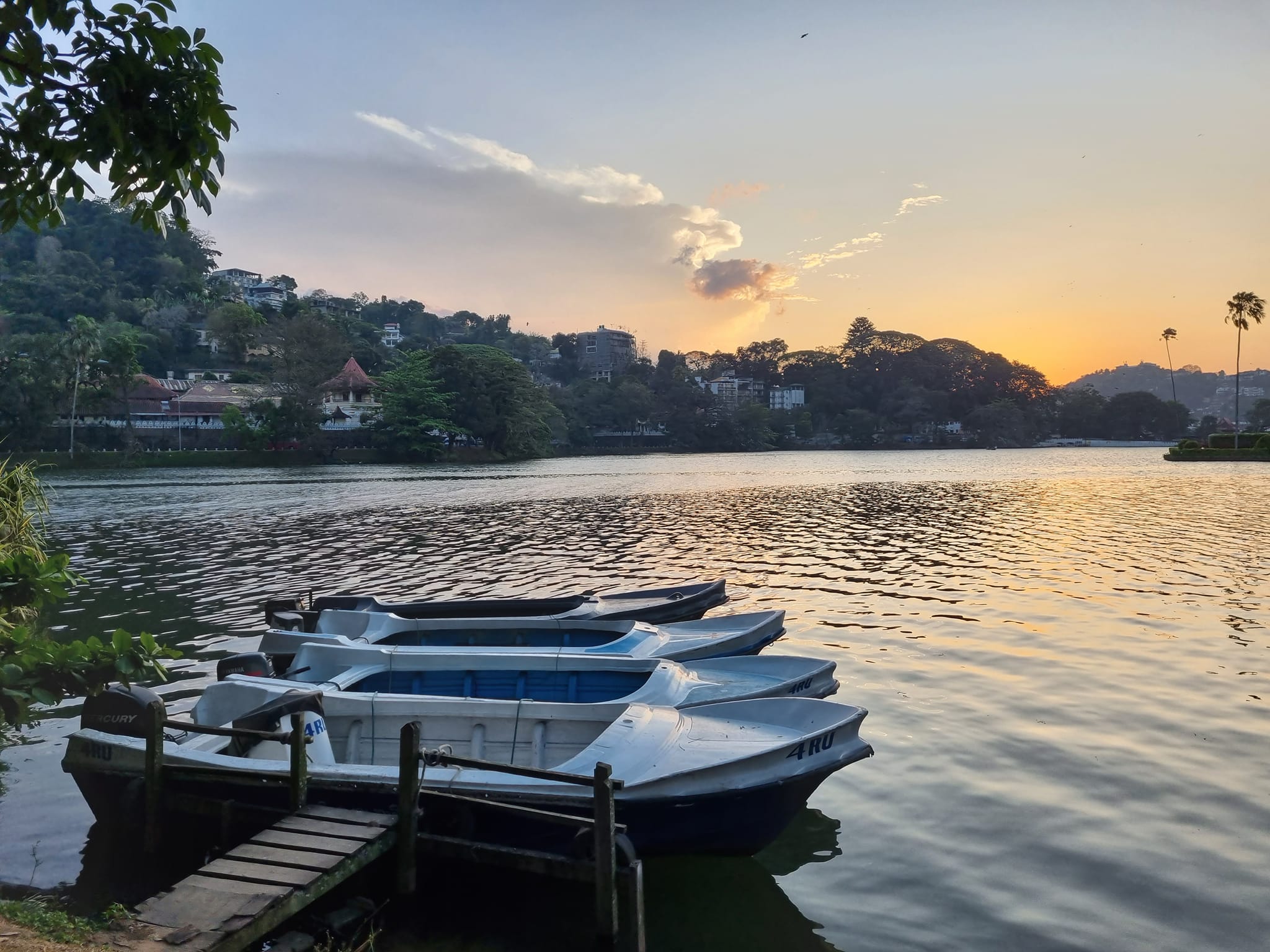
The Royal Palace Complex of Kandy
The Royal Palace of Kandy (known as Mahawàsala), located to the north of the Temple of the Tooth was the royal residence of the Sri lankan monarchy of the Kingdom of Kandy. The last king to reside in it was King Sri Vikrama Rajasinha until his reign ended in 1815.
Once it was large palace complex situated around the Kandy Lake but today only a fraction of the building remains. Like the King’s Palace (Raja Wasala), Royal Audience Hall (Magul Maduwa), Queen’s Palace (Meda Wasala), King’s Harem Quarters (Palle Vahale) and Queen’s Bathing Pavilion (Ulpange), together with the Temple of the Tooth relic (Dalada Maligawa). Adjacent to the Royal Palace is the Victorian era building that housed the Kandy High Court until recently.
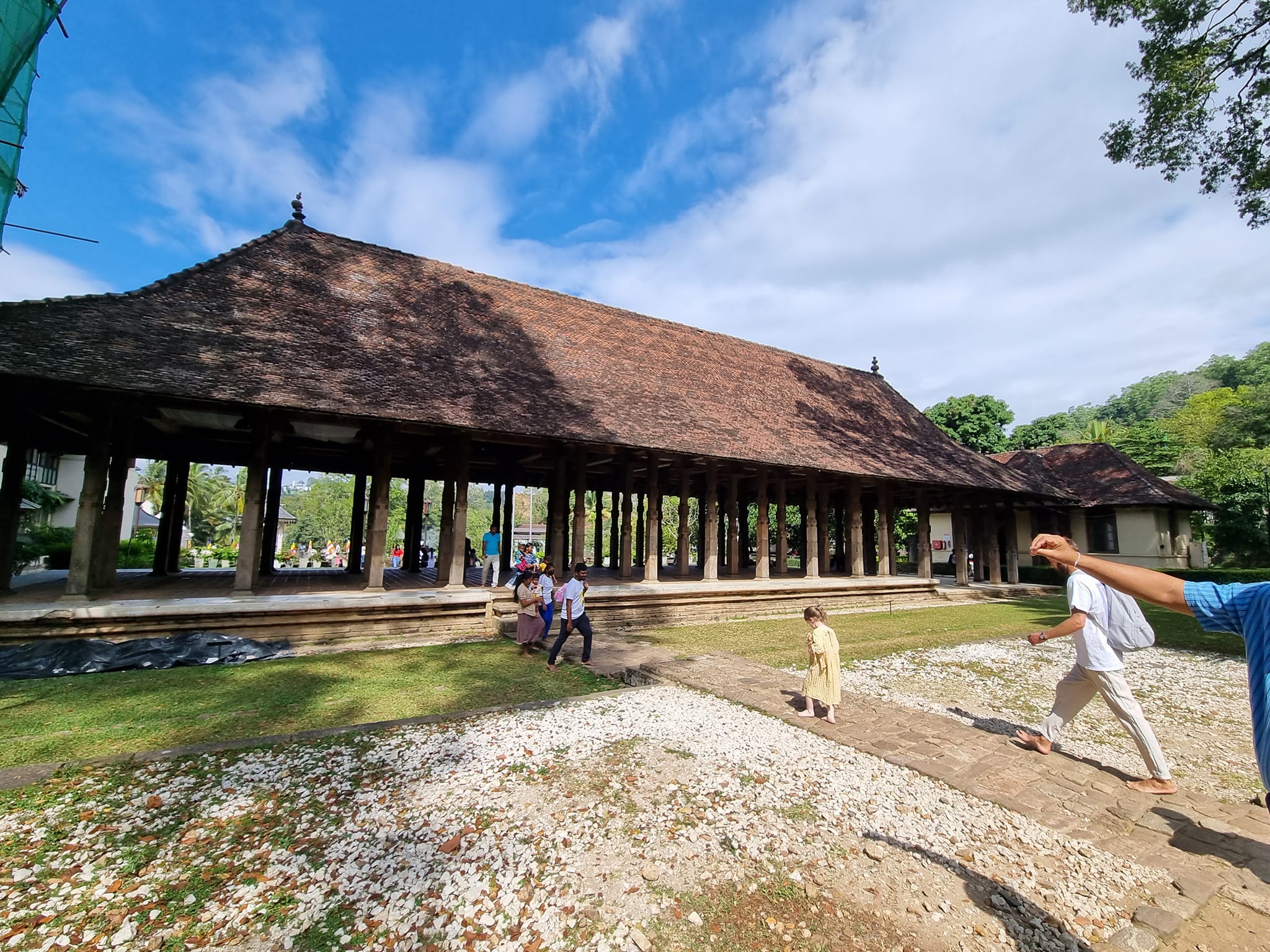
Kandy View-point
Also known as Arthur’s seat, the mesmerizing view point of Kandy gives you a panoramic view of the entire city in one glance. Located on a scenic location atop the Rajapihilla Mawatha, this viewpoint is one of the most visited tourist attractions in Kandy. The place is located near the Kandy Lake and is enclosed in breathtaking landscapes of mountains and meadows. The entire Kandy town lies ahead of your eye from the top with a clear distinct view of the Kandy lake and Dalada Maligawa.
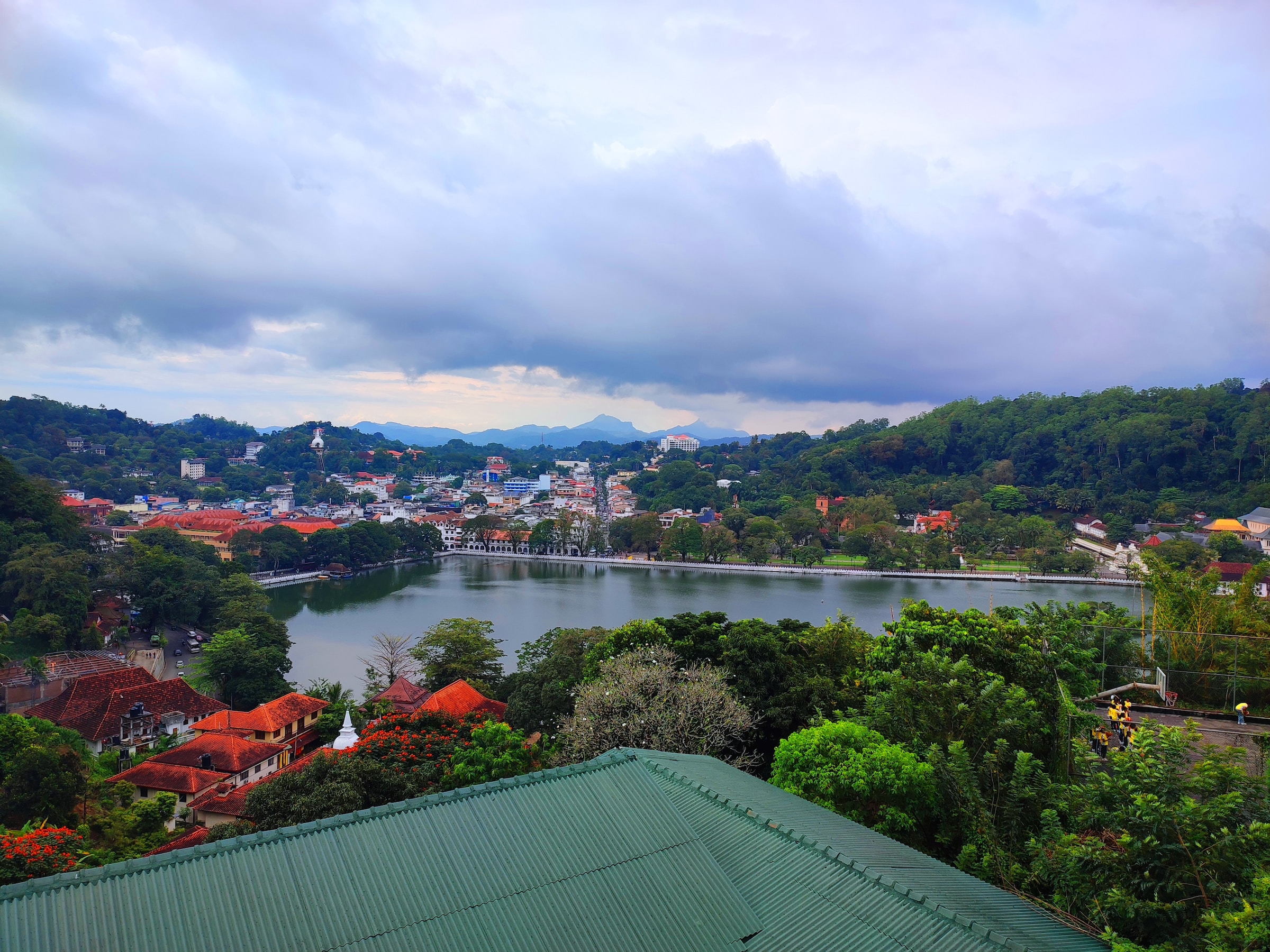
📷Photo by Shamika Nayanajith on Unsplash
Bahirawa Kanda
Situated on a Mountain that is 650 feet above Kandy, the Bahirawa Kanda is of special significance to Buddhists mainly because of the 88-foot Buddha statue on ths summit that faces the Dalada Maligawa. Built in 1972, the statue shows Lord Buddha seated in the Nirvana pose which is associated with his first Enlightenment and is one of the Tallest Buddha statues in Sri Lanka.
Legend has it that a southward branch of the Sri Maha bodhi was planted on this mountain summit with a ‘ran weta’ (golden fence) erected around it.
Behind the great white statue a flight of stairs allows visitors to climb higher up and view the magnificent landscape of the temple’s surroundings. The view is best at night when the city of Kandy is lit by thousands of twinkling lights sparkling like a reflection of the sky.
Kandy National Museum
Located just two minutes walking distance to the Temple of the Tooth, The Kandy National Museum is a part of the former Royal palace of Kandy. Home to over 5000 museum objects depicting various historical aspects and cultural events of the Kandyan era dating back to the 17-19 century A.D.
The primary exhibits are housed in the Palle Vahala building, which was the former home of the King’s harem and was built according to the architectural features of the Kandyan period. A secondary exhibition is located in the main palace building
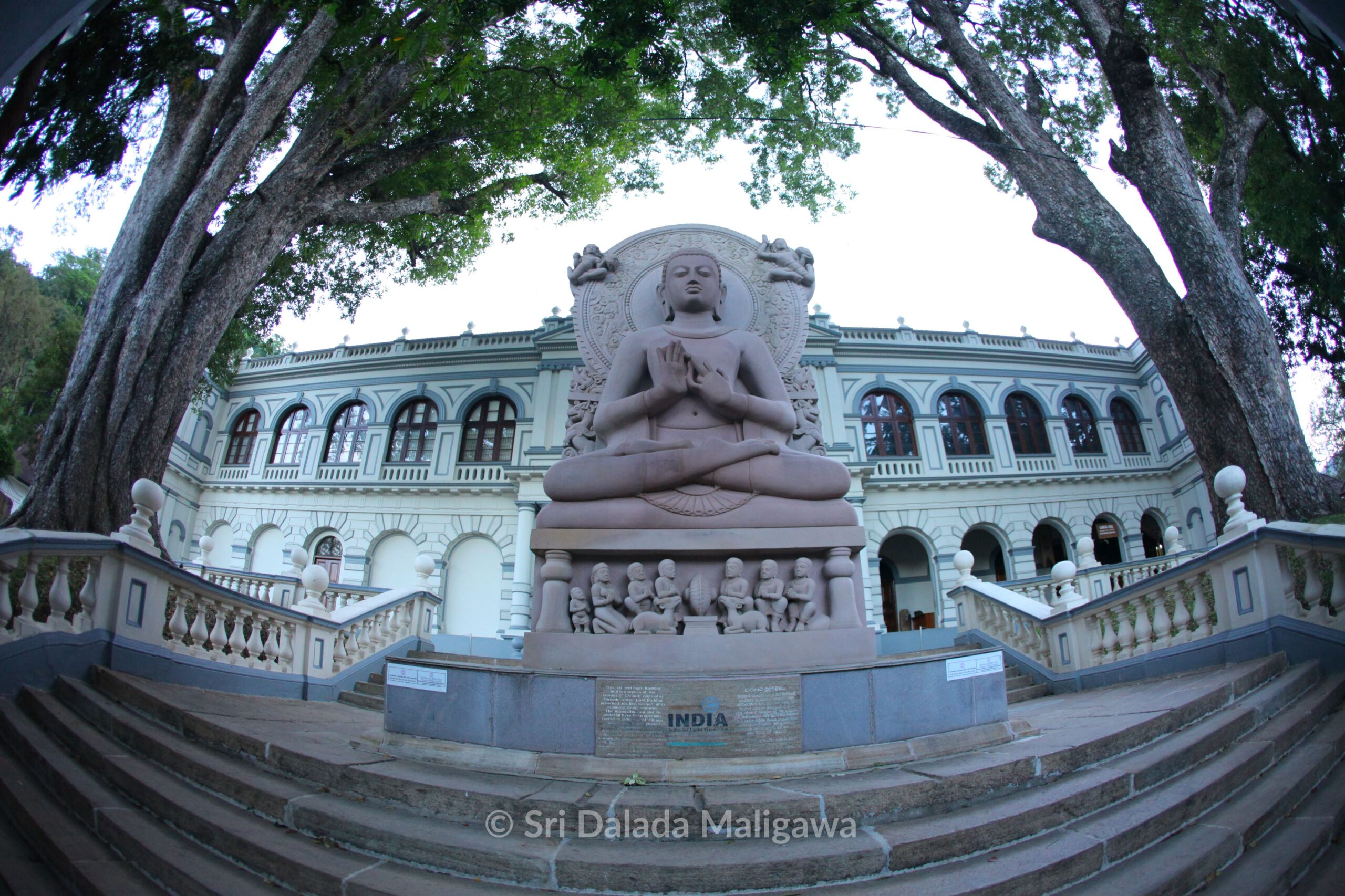
📷Photo by Media & Special Projects Bureau, Sri Dalada Maligawa, Kandy, Sri Lanka.
British Garrison Cemetery
Also known as the Kandy Garrison Cemetery, this British cemetery is located in Kandy for British nationals who died in Ceylon. It was established in 1817 just after British captured the Kandy and closed in 1873 due to a ban on burials within the municipal limits, although special provision was given to allow the burial of relatives of those interred in the cemetery, with last person buried there being Annie Fritz in 1951. The cemetery contains 195 graves of men, women and children. The most common causes of death were tropical diseases such as malaria and cholera.
The cemetery was restored in 1998 and was declared as an Archaeological Protected Monument by the government in July 2011.
Hanthana Mountain Range
The Hanthana Mountain Range lies in the Central highlands of Sri Lanka, south-west of Kandy. It was declared as an environmental protection area in February 2010 under the National Environment Act. The maximum height of the range is 1,200 m (3,800 ft). The mountain range consists of seven peaks and the highest one is the Uura Kanda. The range is a favourite destination among the mountain hikers in Sri Lanka and is situated adjacent to the University of Peradeniya
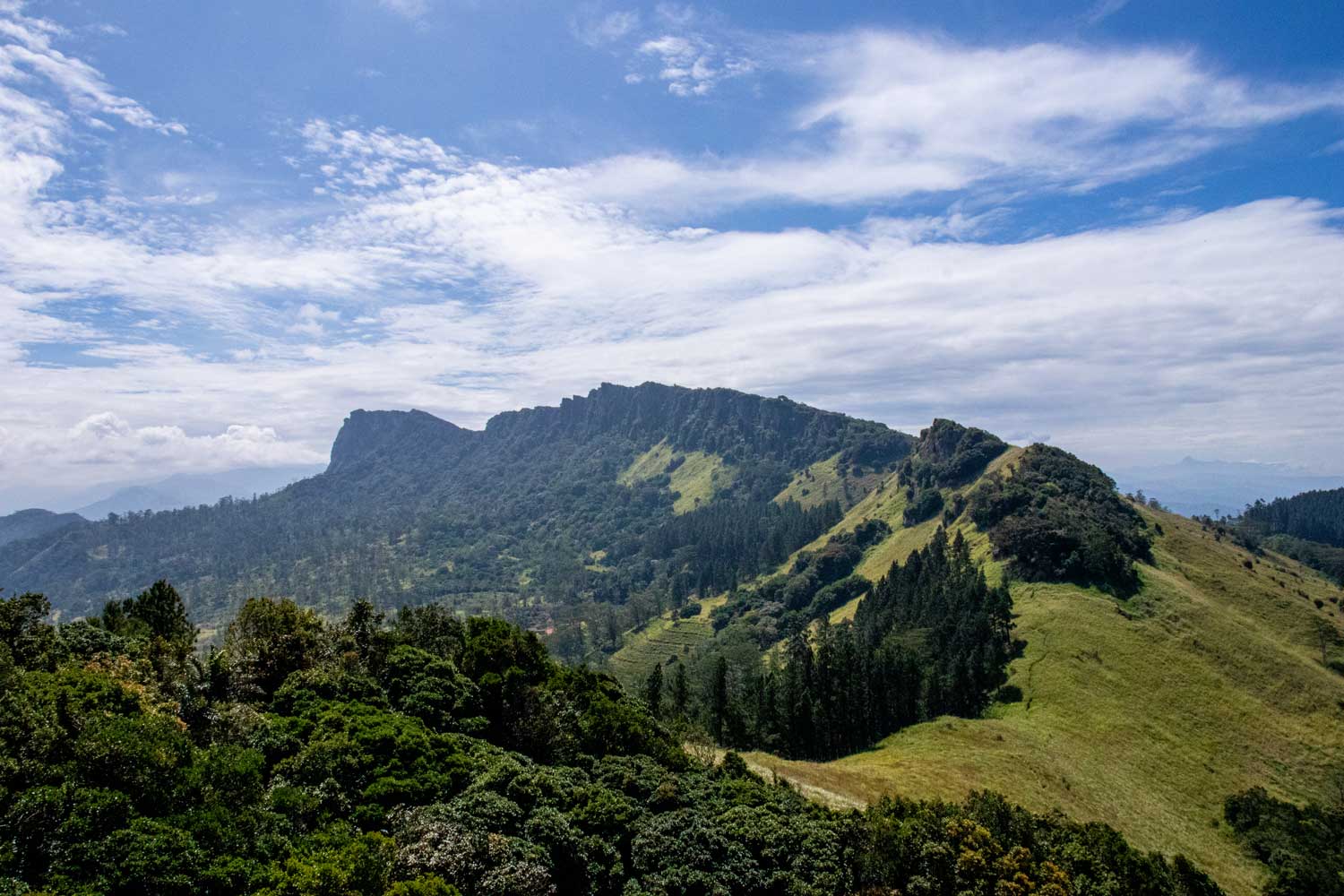
The Ceylon Tea Museum
Situated in Hantane, three kilometres from Kandy city, The Ceylon Tea Museum is served by a motorable road that circles the museum, providing easy access and adequate parking facilities for cars and tourist coaches. The museum consists of four floors comprising of old machinery, a library, an auditorium and a tea café with tea sales outlets where a selection of Sri Lanka’s fine tea is available. The entire top floor is a tea cafe. A panoramic view of the Kandy town surrounded by the beautiful Hunasgiriya, Knuckles Range and the Matale range of hills can be viewed through a telescope mounted on the fourth floor.
An entrance ticket need to be purchased to enter the Tea Museum which is open from Tuesday until Sunday from 8:30am till 3pm and remains closed on Mondays and on poya/public holidays
Kandy War Cemetery
Formerly known as the ‘Pitakande Military Cemetery’, the Kandy War Cemetery is a British military cemetery in Kandy for the burial of soldiers of the British Empire who were killed during World War II as well as a soldier who died during WWI.
There are 203 buried in this cemetery consisting of: 107 British, 35 East Africans, 26 Sri Lankans, 23 Indians, 6 Canadians, 3 Italians, 1 Frenchman and 2 unidentified persons. Of the 203 dead, 151 were army, 32 were air force, 16 were navy, 2 were unidentified, 1 was merchant navy and 1 was from the national fire service.
Royal Botanical Garden – Peradeniya – Kandy Area
Royal Botanical Garden is home to over 4000 species of plants including an extensive collection of colorful flora, medicinal plants, spices, palm trees and more. Located near the Mahaweli river (the longest river in Sri Lanka, the Royal Botanical gardens is renowned for its collection of Orchids and attract nearly 2 million visitors annually. Greatly contributing towards aspects such as floriculture, butterfly and birdlife conservation and concentrating on the sustainability and biodiversity of the island, Peradeniya Botanical Gardens is truly a paradise of tropical greenery, with an abundance of bamboos, lianas and lofty trees to wander amongst.
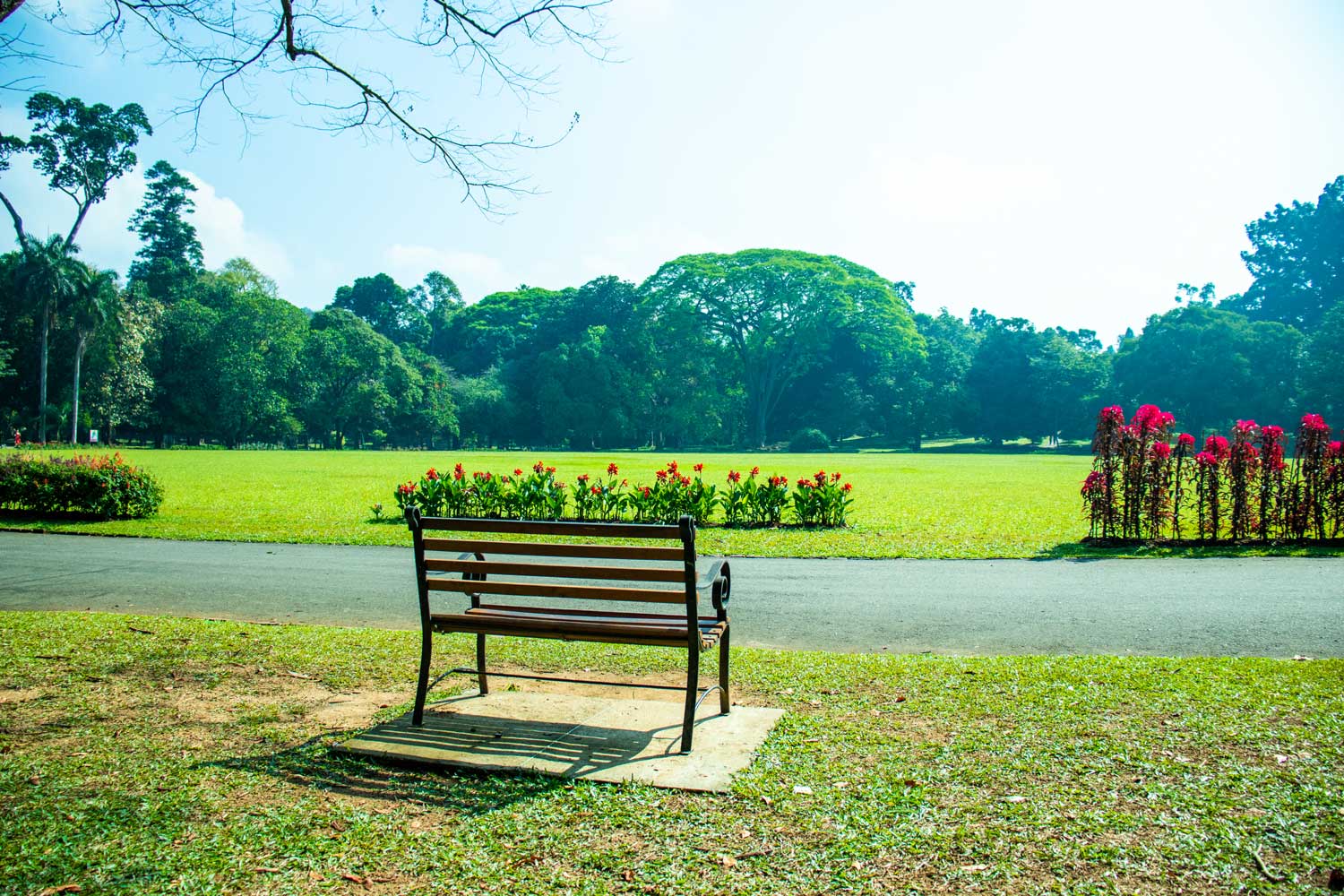
Four Dewala in Kandy – Sathara Maha Dewala
Natha Devalaya
Almost adjoining the Kandy Dalada Maligawa, separated by an imposing brick wall, is the ‘Natha Devalaya’ – the shrine of the Natha Deviyo. The Natha Devala has often been quoted to be the oldest building in the city of Kandy, indicating that the worship of God ‘Natha’ in Kandy could go back to at least the 14th century or even earlier. The Natha Dewala is a significant participant in the annual procession of Kandy best known as the ‘Esala Perahera’.
Vishnu Devalaya
According to local beliefs, Vishnu is a future Buddha after Natha. Therefore, Vishnu always has had a high ranking within the deities worshipped by the Sri Lankans. During the Kandyan Era the Kings “Abisheka Mangallaya” or the Coronation Ceremony was held at this Maha Devale . The Vishnu Devalaya is a long building situated north of the Natha Devalaya, with a storied sanctum at the end and a hall in front that is used by devotees to pray. Clad in Lotus Colour, the Vishnu devala is represented in the Kandy tooth temple procession with its dancers to paying homage to Lord Buddha in the Esala Perahera procession.
Paththini Devalaya
Situated west of Natha Dewalaya, the Paththini Devalaya is a rectangular building on a stone platform. Even though the established time of the Devalaya has not been determined, it is believed that this was built for devotees to visit the Goddess Paththini to bring blessing for children’s diseases, infectious diseases and propitiated in times of drought. The devotees of the Goddess Paththini also participate in the Kandy cultural procession adding female Kandyan dancers and paying homage to the holy tooth relic.
Kataragama Devalaya
Situated about 100m outside the tooth temple complex is Kataragama Devalaya. The main entrance to the Kataragama Devalaya faces the main road with a colourful entrance door or Vahalkada with the main shrine facing the entrance. According to the Tamil belief the deity skanda came to Sri Lanka as result of a noisy quarrel with his wife Thevani and later married a 16 year old ‘walli’ from Katharagama area.
Esala Perahara
Every year in Sri Lanka, for 10 consecutive days to commemorate the Buddha’s Conception, his Renunciation, and the First Sermon. Esala Perahara (procession) journeys city streets in a wave of color, beckoning devotees in their thousands from island wide as well as visitors, to witness a procession like no other. The Esala Perahera in Kandy (also known simply as the Kandy Perahera) is the grandest of the country’s traditional festivals. It is organized by the Dalada Maligawa (Temple of the Tooth Relic) in honor of the Sacred Tooth Relic and the gods Natha, Vishnu, Kataragama and the goddess Pattini.
This Celebration is part of the social tradition of Sri Lanka. This Colourful procession includes Elephants and Kandyan Dancers as well as entertaining circus like elements such as Elephants, sword dancers, fire eaters, stilt walkers etc. The highlight of this parade is when the Sacred Tooth Relic is brought out on the back of a decorated elephant.
This annual procession will be held this year as well from the 21st till the 31st of August.
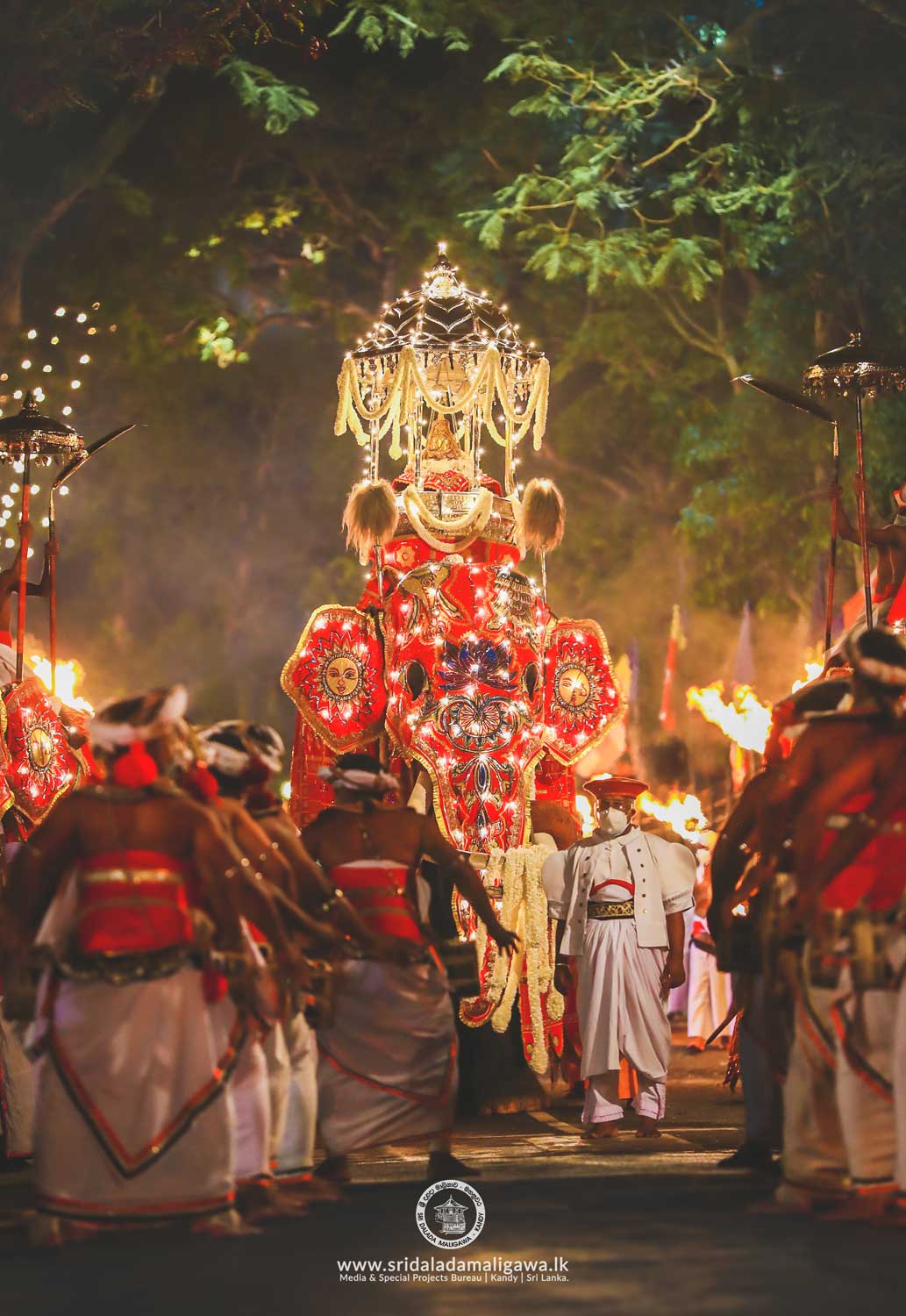
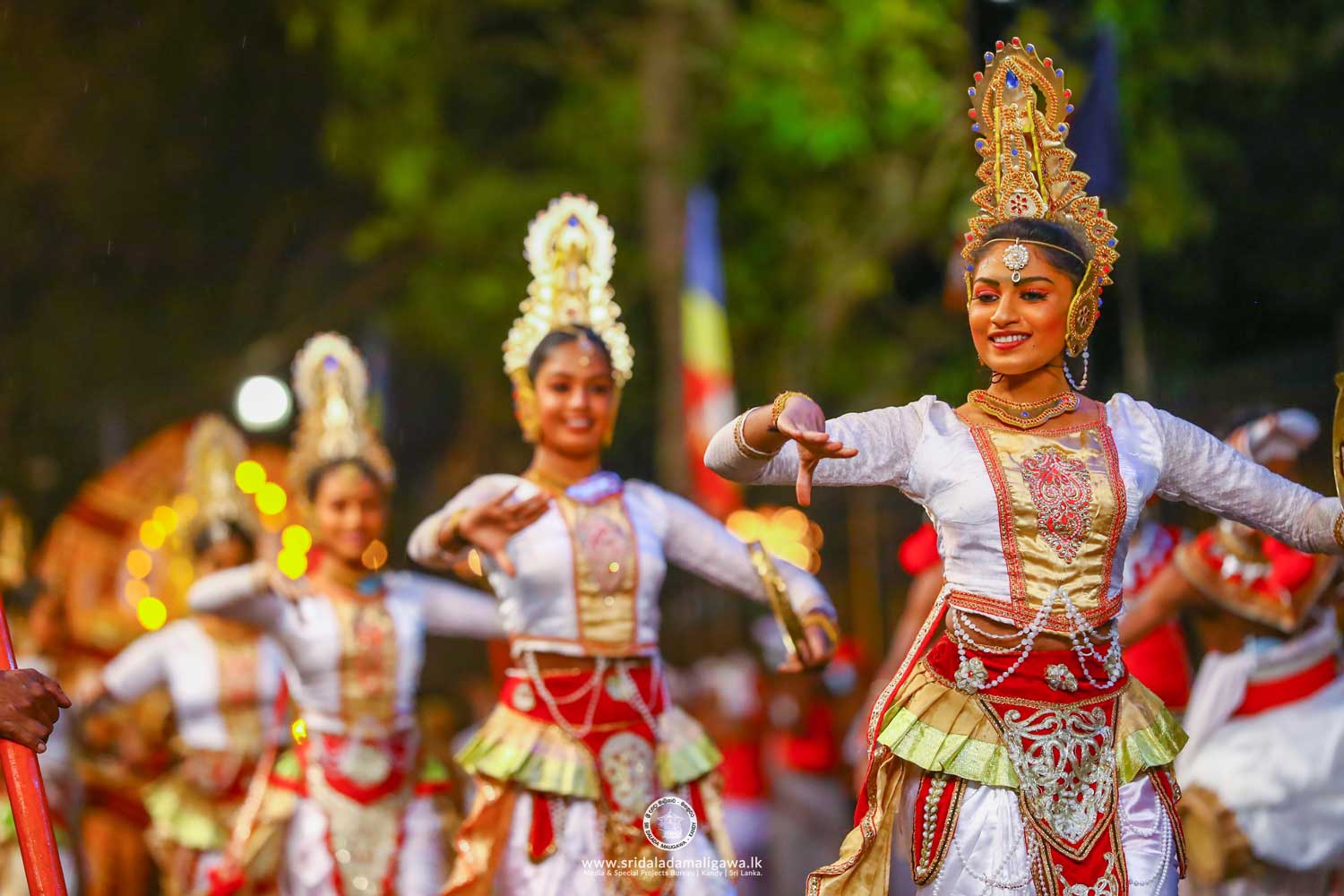
📷Photo by Media & Special Projects Bureau, Sri Dalada Maligawa, Kandy, Sri Lanka.
Contact Luxury Holidays Asia on [email protected] to tailor-make your round tour itinerary in Sri Lanka and ensure that you experience this Colourful annual event this August.




